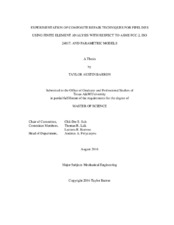Experimentation of Composite Repair Techniques for Pipelines Using Finite Element Analysis with Respect to ASME PCC-2, ISO 24817, and Parametric Models
Abstract
A relatively new method for corrosion repair in steel pipelines has been developed by externally wrapping damaged pipes with composites. Both ASME PCC-2 and ISO 24817, engineering standards concerning pipelines and pipe repairs, have analytical solutions to dictate the minimum composite repair thickness required to safely rehabilitate a corroded steel pipe. When the pipe is assumed to yield into the composite wrap, certain design allowances reduce the necessary composite thickness based upon the live pressure of the composite wrap.
Using finite element analysis, an investigation was carried out to determine whether ASME PCC-2 and ISO 24817 analytical solutions create code compliant composite wraps for various steel wall thinning percentages and live pressures. Results indicate that when considering live pressure, neither ASME nor ISO standards create max hoop strain compliant composite wraps across all wall thinning percentages and live pressures. A parametrically modified version of the ASME PCC-2 standard results in code compliant wraps that more efficiently satisfy the max hoop strain requirement for all tested wall thinning percentages and live pressures.
It is recommended that ASME PCC-2 equation governing composite repairs on pipes with live pressure considerations be updated to include parametric modifiers. This will lead to the creation of more cost efficient, code compliant composite wraps.
Citation
Barron, Taylor Austin (2016). Experimentation of Composite Repair Techniques for Pipelines Using Finite Element Analysis with Respect to ASME PCC-2, ISO 24817, and Parametric Models. Master's thesis, Texas A & M University. Available electronically from https : / /hdl .handle .net /1969 .1 /157743.


